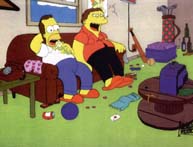This is the first of what will be a series of articles talking about how to go about
collecting, caring for and enjoying animation art. The best advice I can give to

a beginning collector is to educate yourself. Sadly, as there is a lack
of written material on animation art collecting, I would suggest that you
ask questions and read articles. It’s a slow start, but you’ll quickly pick up speed
and make sense of it all. You may also want to visit my web site which has
a page with animation definitions and one comparing limited edition art
and original production art.
I think it’s best that one has a clear understanding of the
different types of animation art that exists as it can be
quite confusing. Let’s start with a few basic definitions.
There are two types of animation art. The first is original
production animation art. Animation art by definition is
any drawing or celluloid that

was used in the making of a cartoon. These pieces are all
one-of-a-kind and involve some type of a hand process-
i.e. drawing or inking/painting.
The other type of art is reproduction art. These are serigraph
cels (sericels) and limited edition cels. This art
was not used in the cartoon making process, but does
resemble the art that was. Sericels are usually made
in editions of a few thousand and created by a silk-screen
type of process. Limited editions are made in smaller
editions of around 500. They are usually hand-painted
and either hand or xeroxed lined. These pieces are not
actually done by the animators, although they may have
had creative input.
Some common questions:
What makes animation art collectable?
Collecting animation art is a wonderful pastime. Cartoon lovers
around the world take great pleasure in owning moments in time
from their favourite cartoons.
Original animation art is collectable because it was used in
the making of a cartoon. It has value on the basis of being
an original hand created piece of art that was used for that
purpose. Furthermore, all pieces are one-of-a-kind and done
by studio artists at the time of the film. The pieces are
limited in number to those made to produce the film, and
most have value also as antiques.
Reproduction art such as limited editions and sericels are
collected as they are very pleasing to look at and recreate
some terrific moments in cartoon history.
What determines the price of a piece of art?
Definitely. Original art is available from £25.

For example, Simpsons cels run between
£275-£500 and Disney cels start at £50. The most expensive
movie is Snow White and pieces are available from £400.
Often, original art is available at a similar, or sometimes
cheaper price than reproduction art. You just have to know
where to look.
Should I buy a limited edition because it is ‘limited’?
My opinion is that you should buy a piece because you like
it. But remember that a piece cannot get any more limited
than one, so original art is much more limited than one
of 500. If you are thinking of buying a piece just because
it is limited, I recommend educating yourself a bit more about
the market first.
Also,the studios sometimes issue limited editions that are
similar (i.e. same characters different poses) to limiteds
that were released at an earlier date, so do factor that
into the equation.
How easy is it to get a signed piece?
A lot of the limiteds
are signed’ so if only the signature is
important to you, then by all means buy one or buy a plain
autograph. Some original art is signed, but try to get the
animators to sign the mat instead if possible, as the original
art was photographed unsigned, and some collectors will not
touch signed art because of that. Also, signatures on cels
can sometimes fade.
These pieces are great ‘investments’, aren’t they?
Some pieces go up in value, some go down. If you are
just looking to buy a piece just as an investment, then
I suggest you think very carefully about that’and don’t
rely on information from someone whose commission depend s
upon your purchasing a piece. I never sell pieces as an
investment, if it was such a sure money-maker, then surely
wouldn’t I keep them all for myself?
I cannot emphasise enough that you buy pieces you like,
whether original or reproduction. But be educated about
what you are buying, and be aware that prices in England
can vary as much as 2-3 times in price. I want everyone
to feel good about collecting animation art, so buy what
you enjoy, understand the art you are buying, and pay a
fair price!





